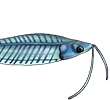Cardone, IB, SE Lima-Junior & R Goitein, 2006. Diet and capture of Hypostomus strigaticeps (Siluriformes, Loricariidae) in a small brazilian stream: relationship with limnological aspects. Brazilian Journal of Biology, 66: 25â??33.
Abstract
The purpose of this study is to ascertain whether variations in the limnological parameters of the Corumbataà river resulting from the discharge of a variety of wastes into its waters may be responsible for spatial shifts in the diet and capture of the armored catfish Hypostomus strigaticeps (Regan, 1907). Individuals were collected over a period of two years from two sites with similar physical, albeit distinct limnological characteristics. As a whole, the environmental variables (temperature, pH, dissolved oxygen, electrical conductivity, and total coliforms and fecal coliforms) of the two sites were found to vary significantly. The food items found in the guts of these armored catfish (sediments, diatoms, fungi hyphae, chlorophytes, cyanophytes and non-identified material) ranked differently in samples from the two sites. In the more polluted (site B), diatoms and chlorophytes ranked higher in the diet than in that of individuals caught in the more preserved location (site A). This fact may be related to the greater amount of organic material found at site B, which provides favorable environmental conditions for such algae and, consequently, for algivorous fishes. Even so, fewer fish were captured at site B than at site A, suggesting that although food is more abundant in the more polluted site, its limnological conditions appear, on the whole, to be less beneficial than the conditions at site A.
Diet and capture of Hypostomus strigaticeps
- Silurus
- Posts: 12420
- Joined: 31 Dec 2002, 11:35
- I've donated: $12.00!
- My articles: 55
- My images: 893
- My catfish: 1
- My cats species list: 90 (i:1, k:0)
- Spotted: 424
- Location 1: Singapore
- Location 2: Moderator Emeritus





